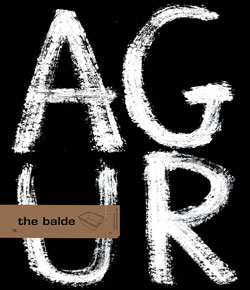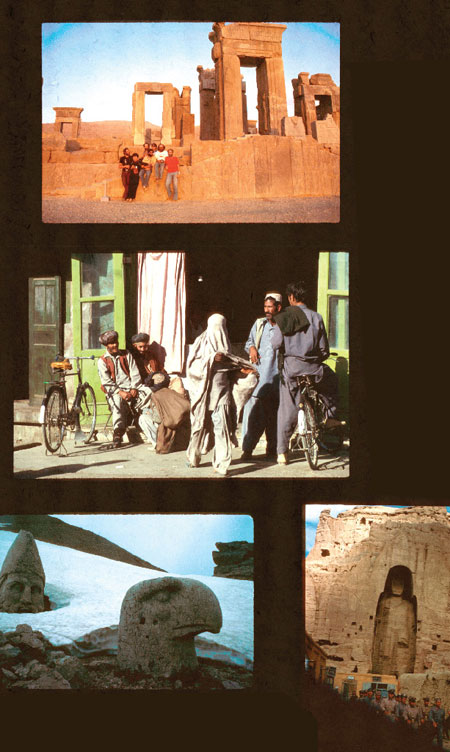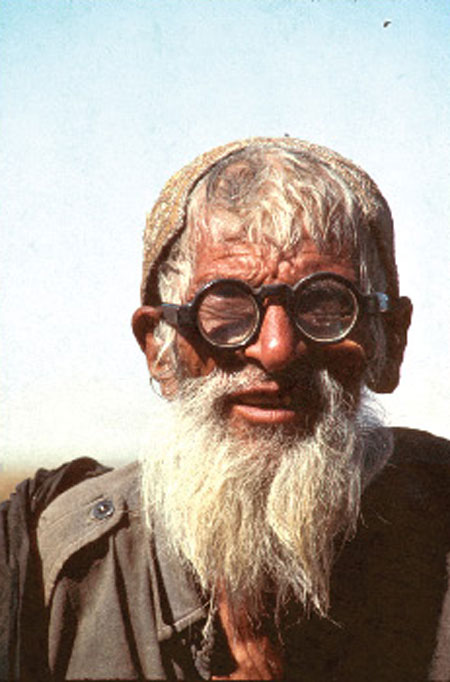mapalimpsestoa harkaitz cano
I pedro de la cruz These photographs were taken during an eight-month journey from Donostia to India by Land Rover in 1978. on the way
It is not possible to behead the way. The way is like a headless snake.
The snake, in its dirty rock nest, has awoken. It doesn’t see the headlights of the cars... It doesn’t even know it’s going to die.
Tents pitched on car roof. Is it to stop the snakes from disturbing the sleep of those who slumber. Is to stop two-footed slithering sly cats from robbing the Land Rovers. When the travellers fall asleep, the ghosts of the desert take over at the wheel. And the sleepers appear in the dreams of the ghost drivers.
The planks that make up the boats tied to the bridge hang on there. Clusters of clams cling to the undersides of the boats and as the colony of clams grows to the rocks all becomes one: the planks and the bridge. We often forget, but what we regard as a steady underfoot is actually water, and we could sink down at any moment.
the gates
A gate and a small white village on the other side. How to explain what snow is: lime.
A door. And on the other side, nothing. Or to put it another way, everything. If they knew that much, the group of friends wouldn’t be so carefree.
It’s the 70s. Who’d have guessed? That green door is nicely painted. It’s surely fallen into disrepair since then. Nobody’s bothered to sand it down and give a new coat of paint. There’s a woman walking, she’s got a white octopus on her head. A beekeeper, a fumigator, a UFO from a B-movie.
heads and statues
The Japanese master has soaked the tip of his paintbrush in blank ink. He’s about to paint a portrait of the old man. First onto the rice paper is the curve oh his beard, followed by the tip of his nose and the twisting frame, the one belonging to the glasses. The portrait is a letter from an unreadable alphabet.
Head held firm. Buried up to the neck in snow. Eyes open. Ahead. Still and all, we have no real interest in the bit below the head resting on the neck, the head’s enough. It’s powerful. The same happens with the eagle: its beak are so strong, we don’t even realise it has no wings. We do not doubt that the eagle can take to the air if it so wishes. Sometimes – not many times all the same – the head is enough.
“Do they bury their dead standing up here?”
“It’s a statue!”
“Do the soldiers watch over the statues here?”
“It’s a corpse!”
the people
This photograph was taken in Persia. Who would have said? Persia doesn’t exist anymore. It’s been scratched off the maps, like it’s some crumpled up wallpaper image to make dresses with. Persia lives on dresses now. On clothes and faces. Persia is like a white robe blowing in the four winds. Persia holds its head up firmly. Persia is: pride without a map.
The power of the combat jacket. Six buttons, well buttoned. A studied pose. It’s not from the country’s army, it’s from another one. No doubt about that. When the wars finish, at the entrances to small villages they sell medals, clothes, pictures and lumps of rock. The crumbs dead soldiers left behind. Souvenirs for next to nothing. His beard is of two colours: white and orange. It’s as if he’s saying: “This is my flag” or “I’m still alive, unlike the previous owner of this jacket.”
A child’s memory: cleaning his bloody knife in the sand. Better have breakfast and get off to look after those sheep.
Wanna know their nicknames? Olive Erkin, Laid back and daring, The Storyteller, Don’t-look-at-me-like-that and Mr Pragmatic. The grading of race and character. Each one has their origins, their weapons and their pride. If we were playing poker: a straight flush.
They’re angry. They are not posing, no sir. They don’t take their hands off their rifles as they look across at the photographer, eager to continue on with their journey. The bike leaning against the wall has a conscience of its own and a sarcastic quip springs to mind: “I’m up against the wall but I won’t be shot just yet.”
Dust: uproar over a missing sheep. The wolf is not to blame.
The one in the middle thinks: “The rest of them are sitting nice and easy, but I won’t be lax. That’s why I’m still standing... Look at my shadow, bent over like an abbot, like Death from The West, I have a secret and my shadow has another one. We don’t know each other’s secret.”
The point where shame disappears: these boys have no fear of being in the front line and having their picture taken. They look straight at us through the lens. The shy girls hang around at the back, to timid to approach. Further back again are those who don’t come nearer out of shyness and because they have to work. Humble work should be a synonym of harvesting.
It is not possible to behead the way. The way is like a headless snake.
The snake, in its dirty rock nest, has awoken. It doesn’t see the headlights of the cars... It doesn’t even know it’s going to die.
Tents pitched on car roof. Is it to stop the snakes from disturbing the sleep of those who slumber. Is to stop two-footed slithering sly cats from robbing the Land Rovers. When the travellers fall asleep, the ghosts of the desert take over at the wheel. And the sleepers appear in the dreams of the ghost drivers.
The planks that make up the boats tied to the bridge hang on there. Clusters of clams cling to the undersides of the boats and as the colony of clams grows to the rocks all becomes one: the planks and the bridge. We often forget, but what we regard as a steady underfoot is actually water, and we could sink down at any moment.
the gates
A gate and a small white village on the other side. How to explain what snow is: lime.
A door. And on the other side, nothing. Or to put it another way, everything. If they knew that much, the group of friends wouldn’t be so carefree.
It’s the 70s. Who’d have guessed? That green door is nicely painted. It’s surely fallen into disrepair since then. Nobody’s bothered to sand it down and give a new coat of paint. There’s a woman walking, she’s got a white octopus on her head. A beekeeper, a fumigator, a UFO from a B-movie.
heads and statues
The Japanese master has soaked the tip of his paintbrush in blank ink. He’s about to paint a portrait of the old man. First onto the rice paper is the curve oh his beard, followed by the tip of his nose and the twisting frame, the one belonging to the glasses. The portrait is a letter from an unreadable alphabet.
Head held firm. Buried up to the neck in snow. Eyes open. Ahead. Still and all, we have no real interest in the bit below the head resting on the neck, the head’s enough. It’s powerful. The same happens with the eagle: its beak are so strong, we don’t even realise it has no wings. We do not doubt that the eagle can take to the air if it so wishes. Sometimes – not many times all the same – the head is enough.
“Do they bury their dead standing up here?”
“It’s a statue!”
“Do the soldiers watch over the statues here?”
“It’s a corpse!”
the people
This photograph was taken in Persia. Who would have said? Persia doesn’t exist anymore. It’s been scratched off the maps, like it’s some crumpled up wallpaper image to make dresses with. Persia lives on dresses now. On clothes and faces. Persia is like a white robe blowing in the four winds. Persia holds its head up firmly. Persia is: pride without a map.
The power of the combat jacket. Six buttons, well buttoned. A studied pose. It’s not from the country’s army, it’s from another one. No doubt about that. When the wars finish, at the entrances to small villages they sell medals, clothes, pictures and lumps of rock. The crumbs dead soldiers left behind. Souvenirs for next to nothing. His beard is of two colours: white and orange. It’s as if he’s saying: “This is my flag” or “I’m still alive, unlike the previous owner of this jacket.”
A child’s memory: cleaning his bloody knife in the sand. Better have breakfast and get off to look after those sheep.
Wanna know their nicknames? Olive Erkin, Laid back and daring, The Storyteller, Don’t-look-at-me-like-that and Mr Pragmatic. The grading of race and character. Each one has their origins, their weapons and their pride. If we were playing poker: a straight flush.
They’re angry. They are not posing, no sir. They don’t take their hands off their rifles as they look across at the photographer, eager to continue on with their journey. The bike leaning against the wall has a conscience of its own and a sarcastic quip springs to mind: “I’m up against the wall but I won’t be shot just yet.”
Dust: uproar over a missing sheep. The wolf is not to blame.
The one in the middle thinks: “The rest of them are sitting nice and easy, but I won’t be lax. That’s why I’m still standing... Look at my shadow, bent over like an abbot, like Death from The West, I have a secret and my shadow has another one. We don’t know each other’s secret.”
The point where shame disappears: these boys have no fear of being in the front line and having their picture taken. They look straight at us through the lens. The shy girls hang around at the back, to timid to approach. Further back again are those who don’t come nearer out of shyness and because they have to work. Humble work should be a synonym of harvesting.




